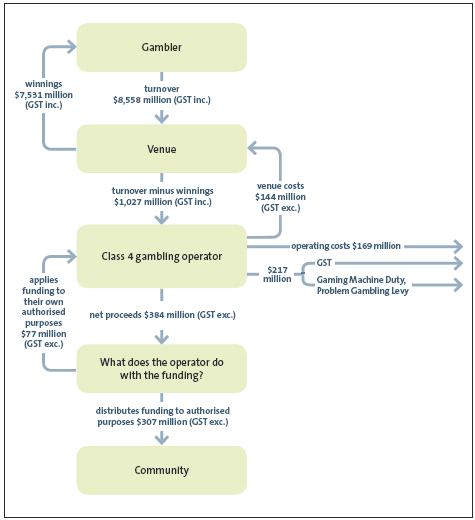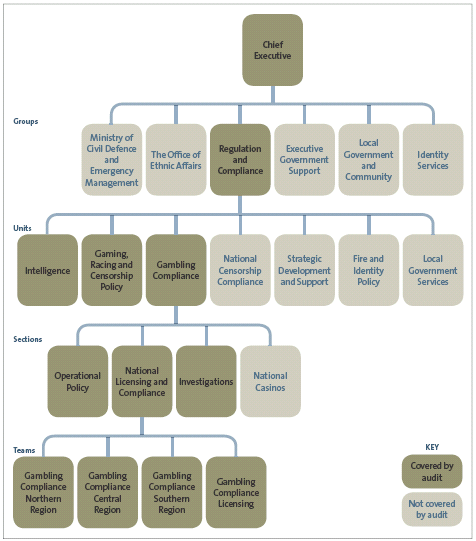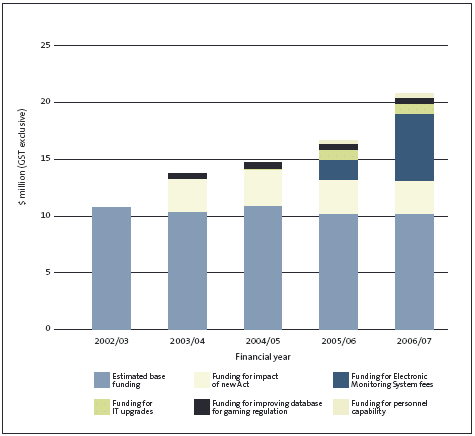Part 1: Non-casino gaming machines and our audit
What are non-casino gaming machines?
1.1
Non-casino gaming machines are devices that are totally or partly mechanically or electronically operated for gambling in venues other than casinos. They are commonly known as “pokie” machines, and are usually located in hotels or clubs.
1.2
The Department of Internal Affairs (the Department) estimates that about $8,500 million (including GST) was spent in 2004-05 in non-casino gaming machines. The Department estimates that about $7,500 million (including GST) of this total was returned to gamblers as winnings and about $384 million (excluding GST) was given to the community (including clubs returning funds to their own community purposes)1. The remainder goes to taxes and charges (GST, Gaming Machine Duty, and Problem Gambling Levy) and to the operating costs of operators of the machines and the venues where the machines are located.
1.3
Funds from non-casino gaming machines are provided to the community in two ways:
- through grant arrangements with operators that provide funds to community groups for certain purposes. Under these arrangements the operators distributing the funds do not directly benefit from them. These operators are said to “distribute” funds for authorised purposes; and
- through funds being returned to the operators of the machines in addition to any operating costs received by the operators. These operators are generally clubs, and are said to “apply” funds to their own authorised purposes.
1.4
Some operators may both distribute and apply funds.
1.5
The Department estimates that, in 2004/05, about $307 million (excluding GST) was distributed to the community and about $77 million (excluding GST) was applied to operators in the community.
1.6
Figure 1 summarises what happens to funds placed in a non-casino gaming machine. It shows information for the 2004/05 financial year.
1.7
The non-casino gaming machine industry (the industry) is consolidating. Some of the main trends include decreasing numbers of operators, venues, and machines. Until 2004/05, there was a rapidly increasing amount of money spent on non-casino gaming machines.
Figure 1
Estimated funding flows from the gambler to the community in 2004/05

Notes:
Figures are estimates provided by the Department of Internal Affairs. We have not verified these figures as part of our audit.
Figures do not add exactly due to rounding to the nearest million.
Turnover and winnings figures include churn. Churn refers to reinvestment of funds during a gaming session.
Calculation of winnings assumes an 88% win ratio.
Calculation of venue costs assumes that 80% of proceeds are attributable to public venues and venue payments at 19.7% of turnover.
Calculation of taxes and levies assumes tax of 20% and levies of 1.11%.
Calculation of returns to the community assumes that 42.032% of turnover minus winnings are returned, with 20% of that being applied and 80% being distributed.
1.8
There has been a small reduction in estimated player losses (the total difference between funds placed in a machine and winnings paid out) from $1,035 million (including GST) across all operators for operators’ financial years ending in 2004 to $1,027 million (including GST) for operators’ financial years ending in 2005. The Department believes that player losses in 2005/06 were about $900 million (including GST), and that player losses will remain steady at about this amount.
1.9
We have not attempted to investigate how consolidation might be related to the introduction of the Gambling Act 2003 (the Act) because:
- this is a large and complex question that is outside the scope of our audit;
- not all aspects of the Act are fully implemented yet; and
- some consolidation was occurring before the Act was passed.
1.10
To illustrate the longer term trends in non-casino gambling, since 2001 there has been about:
- a doubling of the average total estimated gamblers’ losses for each gaming machine;
- a tripling of the average total estimated gamblers’ losses for each venue; and
- a quadrupling of the average total estimated gamblers’ losses for each operator.
1.11
Because of the very large amount of funds involved and the potential for gambling to cause harm, it is important that effective controls are in place for managing non-casino gaming machines.
What is the role of the Department of Internal Affairs?
1.12
The Act sets out the legislative framework for controls on non-casino gaming machines. The Department is responsible for administering the controls in the Act.
1.13
The principal control is the licensing of operators of gaming machines and the venues where the machines are located. The Department is responsible for issuing and renewing these licences. It charges fees for them. The fees are used to fund the Department’s licensing and compliance activities.
1.14
The Department is also responsible for monitoring and enforcing compliance with the licence conditions and subordinate legislation. The Department’s Gambling Compliance Unit undertakes this work as well as the licensing work. As at 24 January 2007, the unit had 50.5 full-time equivalent positions.
1.15
Figure 2 sets out the Department’s organisational structure, and shows the group, units, sections, and teams covered by our audit. Staff in the Gambling Compliance regional offices work almost exclusively on non-casino gaming machines and not on other forms of gambling.
Figure 2
Organisational structure of the Department of Internal Affairs

1.16
Figure 3 shows the funding received by the Department for all gambling (including casino and non-casino gambling) and associated regulatory activities, and the additional funding made available to the Department for the costs of the impact of the new Act and associated initiatives (mainly information technology initiatives).
Figure 3
Funding for gambling and associated regulatory services 2002/03 to 2006/07

Note: Total funding is as reported by the Department to us for this audit. Base funding is estimated by subtracting funding for specific initiatives, as recorded in the Estimates of Appropriations, from the total gambling and associated regulatory activities funding reported to us by the Department.
Gambling Act 2003
1.17
The Act is relatively new, having come into force in 2004. At the time of our audit, not all of the provisions of the Act and regulations under the Act (for example, those relating to an Electronic Monitoring System) were fully implemented. To implement the Act, the Department had to do a lot of work in a short time, particularly in licensing.
1.18
The Act replaced the Gaming and Lotteries Act 1977 and the Casino Control Act 1990. According to the Department, the Act “makes it much harder to get a gaming machine licence and much easier to lose it” compared with the previous legislation.
Electronic monitoring
1.19
Electronic monitoring of gaming machines (EMS) had not been fully implemented at the time of our audit. All operators must have their machines connected by March 2007. We did not audit EMS, as it is not yet fully implemented. EMS should allow the Department to –
- monitor how much money is gambled on each gaming machine
- monitor how much money each machine pays out in prizes to gamblers
- monitor how much money should be banked
- ensure that all software being used on machines is identical to the approved versions
- assist in detecting software failures
- assist in detecting tampering with a machine or software.2
1.20
In effect, EMS will automate the collection of information that is currently collected manually. EMS will not assist with compliance activities relating to venue or operator expenses, operators’ grant processes, or the use of grants by recipients.
1.21
Until EMS is in place, turnover from non-casino gaming machines will continue to be recorded manually using information displayed on meters in the machines.
Findings of our previous audits
1.22
In 1992, we published a report – Department of Internal Affairs: Control of Gaming under the Gaming and Lotteries Act 1977.3 The report highlighted the need for increased monitoring of gaming machine operations by the Department. It also found that the Department had recognised the need for specific legislation to enable it to control gaming machines.
1.23
We undertook a follow-up review in 1998.4 The review recommended a new legislative framework and a better balance in the Department’s gaming machine compliance activities. At the time, the Department focused on auditing operators considered high risk and did no random auditing of other operators. The review also found that, at that time, the Department was not spending all of the money it received from annual gaming machine licence fees on gaming machine compliance, despite this being the purpose of the fees. It therefore potentially had funding available for more auditing work.
1.24
In our view, our current audit of the Department’s controls on non-casino gaming machines was timely, given these past findings and the enactment of the Act.
How we approached this audit
1.25
We examined the effectiveness of the Department’s controls on non-casino gaming machines. We focused on three main areas of the Department’s controls. These are the effectiveness of the Department’s policies and procedures for ensuring that:
- non-casino gaming machine operators and venues are licensed – to ensure that only those persons and organisations who meet the requirements of the Act are able to enter and remain in the industry;
- non-casino gaming machine operator and venue costs are appropriate – this is because inappropriate costs reduce the funds subsequently available to the community; and
- funds are distributed or applied to authorised purposes (under the Act), including through grants – if funds are used for other purposes, they are not benefiting the community in the manner intended by the Act.
1.26
Specifically, we examined whether:
- intelligence and a risk-based approach inform the application of policies and procedures;
- the policies and procedures are consistent with the relevant requirements in the Act;
- the policies and procedures are followed by the Department; and
- the policies and procedures are periodically reviewed and updated.
1.27
To examine the effectiveness of the Department’s controls, we used complementary sources of evidence. These included:
- interviewing a range of the Department’s staff in its national and three regional offices, operators, a Gambling Commission representative, and industry organisations;
- examining the Department’s documents, including reviewing files held in the Department’s national and regional offices;
- reviewing a sample of selected operators’ licence applications or renewals against the Department’s stated policies and procedures; and
- observing some of the Department’s processes in action.
1.28
Our audit focused on the Department’s policies and procedures that help ensure that funds return to the community. We did not examine the actual funds going to the community or the use of or effect of the funds in the community. These were outside the scope of our audit. We also did not examine the Department’s oversight of activities to minimise harm from gambling in the sector. These activities are worthy of separate study.
1.29
The Department told us that it has “no role in determining the specific authorised purposes that funds are used for”. It is up to operators to determine the actual recipients and specific uses of funds within the broad purposes in the Act and within the statements of authorised purpose approved by the Department.
1: We have not attempted to verify these figures as part of our audit because they are being used to provide context only. The figures include “churn”. Churn refers to reinvestment of funds during a gaming session. For example, if a player puts $20 into a gaming machine, wins $10 of this back, and then places $5 of the winnings in the machine, the player would have put a total of $25 into the machine and have $10 in winnings, a net loss of $15. In the figures above, the turnover for this example would be recorded as $25 rather than the net loss of $15.
2: Gambits, Department of Internal Affairs, December 2004, page 17.
3: ISBN 0-477-02845-9.
4: Third Report for 1998, parliamentary paper B.29[98c], pages 53-72.
page top
